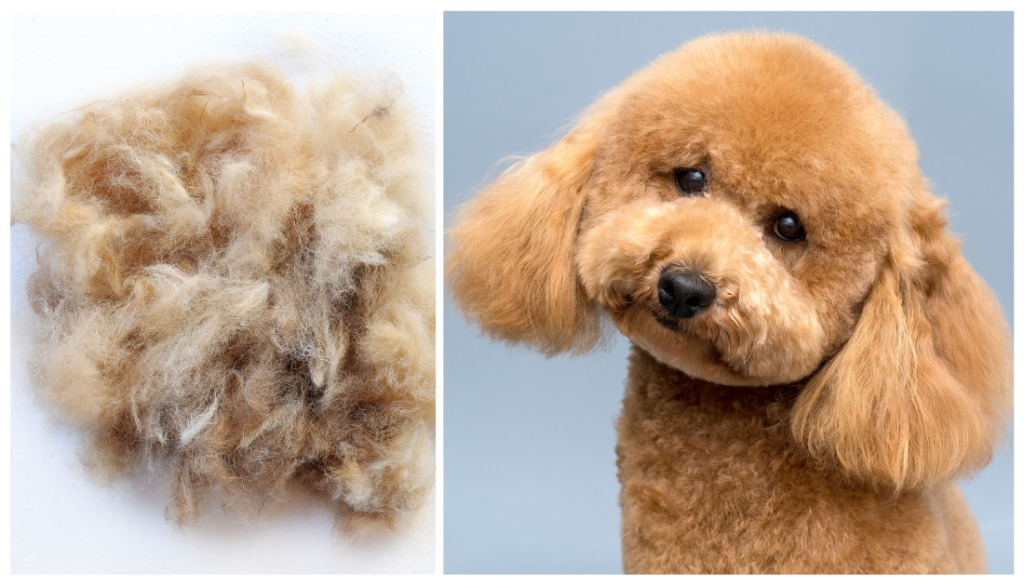Curious about whether poodle mixes shed? Well, here’s a surprising fact for you: poodle mixes, also known as doodles, are often considered hypoallergenic because they have low to no shedding! Yes, you heard it right, these adorable pooches are a great choice for those who are sensitive to pet dander or simply don’t want to deal with excessive shedding. But how is this possible? Let’s further explore the fascinating world of poodle mixes and their shedding tendencies.
Poodle mixes, such as Goldendoodles and Labradoodles, inherit their low shedding traits from their poodle parent. Poodles have a unique curly and wiry coat that doesn’t shed much. This coat type, combined with the coat of their other parent breed, creates a variety of poodle mixes with different coat textures and shedding tendencies. The fact that poodle mixes shed less can be attributed to their curly and hypoallergenic coats. With their minimal shedding, poodle mixes offer a practical solution for people who want a furry companion without the hassle of constant shedding. Now you can enjoy the best of both worlds: a loving pet and a clean house!
Most poodle mixes, or doodles, have a low-shedding coat. This is because poodles have a curly, non-shedding coat that is inherited by their mixed offspring. However, the degree of shedding can vary depending on the specific mix and the individual dog. Regular grooming and brushing can help minimize shedding and keep their coats healthy. Overall, poodle mixes are a great choice for those who are sensitive to dog allergens or prefer a low-shedding pet.

The Lowdown on Poodle Mixes and Shedding
Poodle mixes, also known as “doodles,” have gained popularity as family pets due to their intelligence, hypoallergenic qualities, and friendly nature. However, one important question that potential dog owners often ask is, “Do poodle mixes shed?” Understanding the shedding tendencies of poodle mixes is crucial for individuals with allergies or those seeking a dog with minimal shedding. In this article, we will explore the shedding traits of poodle mixes, factors that influence shedding, and tips for managing their coat to minimize shedding.
Understanding Poodle and Poodle Mixes’ Coat
To determine if poodle mixes shed, it is essential to understand the coat characteristics of poodles and poodle mixes. Poodles have a unique coat that is curly, dense, and effectively traps shed hair instead of letting it fall off. This quality makes poodles a popular breed among people with allergies or those looking for a low-shedding dog.
Poodle mixes, or crossbreeds, inherit their coat traits from their poodle parent. Depending on the mix, poodle mixes can have a curly, wavy, or straight coat. The degree of shedding in a poodle mix might vary depending on the mix’s other parent’s breed and their fur type. It is important to note that no dog breed is completely hypoallergenic, but poodle mixes tend to produce fewer allergens due to their minimal shedding.
Factors Influencing Shedding in Poodle Mixes
While poodle mixes generally shed less compared to other breeds, several factors can influence the amount of shedding they experience:
1. F1 Generation or Multi-Generational Mixes
The shedding tendencies of poodle mixes can vary based on whether they are an F1 generation or a multi-generational mix. An F1 generation poodle mix has one poodle parent and one parent from another breed. These mixes may shed more since they have a wider range of genetic influences. Multi-generational mixes, on the other hand, have both parents that are poodle mixes. These dogs are more likely to have a coat that resembles that of a poodle, leading to minimal shedding.
2. Fur Type
The fur type of the non-poodle parent can also affect the shedding tendencies of poodle mixes. For example, if the other parent has a double coat, the poodle mix may inherit some of the shedding traits from that breed. Conversely, if the other parent has a single coat, the poodle mix is more likely to have minimal shedding.
3. Coat Maintenance
The way the coat is maintained also plays a role in shedding. Regular grooming, including brushing and bathing, reduces shedding by removing loose and dead hair. Keeping the coat healthy through proper nutrition can also minimize shedding. Additionally, certain poodle mixes, like the Labradoodle or Goldendoodle, may have more manageable shedding when their coat is kept at a medium length, rather than being too short or too long.
Tips for Managing Shedding in Poodle Mixes
If you are considering a poodle mix and want to minimize shedding, here are some tips:
- Regular grooming: Establish a grooming routine that includes brushing your dog’s coat at least once a week. This helps remove loose hair and prevents matting.
- Professional grooming: Consider taking your poodle mix to a professional groomer for regular haircuts and maintenance. A groomer can help keep the coat tidy and minimize shedding.
- Bathing: Bathe your poodle mix as needed, using a hypoallergenic shampoo. This keeps the coat clean and healthy.
- Diet and nutrition: Feed your poodle mix a balanced and nutritious diet to promote a healthy coat. Omega-3 fatty acids can enhance coat health and reduce shedding.
- Avoid stress: Stress can contribute to excessive shedding in dogs. Provide a calm and comfortable environment for your poodle mix to minimize stress.
Comparing Shedding in Poodle Mixes
To give you a better understanding of the shedding tendencies in various poodle mixes, here is a comparison:
| Poodle Mix | Shedding Level |
| Labradoodle | Low to Moderate |
| Goldendoodle | Low to Moderate |
| Cockapoo | Low to Moderate |
| Maltipoo | Low to Moderate |
| Bernedoodle | Low |
Key Takeaways
- Poodle mixes, also known as doodles, can have different shedding levels depending on their specific mix.
- Poodles themselves are known for being low-shedding dogs.
- Some doodles may inherit the low-shedding gene from their poodle parent, making them hypoallergenic.
- However, not all poodle mixes are hypoallergenic, and some can shed quite a bit.
- If shedding is a concern for you, it’s important to research the specific mix you’re interested in to understand their shedding tendencies.
Frequently Asked Questions
When it comes to considering a poodle mix as a pet, one common question that dog lovers have is whether these mixed breeds shed. While poodles are known for their low-shedding coats, the shedding tendency can be influenced by the other breed in the mix. Here are answers to some frequently asked questions about shedding in poodle mixes.
1. Do poodle mixes shed?
Poodle mixes, also known as doodles, can vary when it comes to shedding. The shedding potential of a poodle mix depends on various factors such as the type of coat, generation of the mix, and the individual dog. Some poodle mixes, like F1B (poodle crossback to a poodle), are more likely to have low-shedding coats because they have a higher percentage of poodle genetics. However, even within the same litter, there can be variations in shedding levels. It’s important to note that no dog is truly hypoallergenic, but poodle mixes tend to produce fewer allergens than some other breeds.
If you are considering a poodle mix as a pet and are concerned about shedding, it’s best to research the specific mix you are interested in and consult with a reputable breeder or rescue organization. They can provide information on the shedding tendencies of the mix and help you find a dog that suits your preferences and lifestyle.
2. What factors influence shedding in poodle mixes?
Several factors can influence the shedding tendency in poodle mixes:
- Coat type: The type of coat a poodle mix inherits from its parent breeds can greatly affect shedding. For example, a poodle mix with a curly or wavy coat is more likely to have minimal shedding compared to a mix with a straight or wiry coat.
- Generation of the mix: The generation of the poodle mix can also impact shedding. F1B and higher generation mixes, which have a greater percentage of poodle genetics, are more likely to have low-shedding coats.
- Individual dog: Each dog is unique, so even within the same mix, there may be variations in shedding. Some poodle mixes may take after their poodle parent and have minimal shedding, while others may have a coat more similar to the non-poodle parent and shed more.
Understanding these factors can help you make an informed decision when choosing a poodle mix as a pet.
3. How can I manage shedding in a poodle mix?
While poodle mixes tend to shed less than some other breeds, regular grooming and maintenance are still important to manage shedding and keep your dog’s coat healthy. Here are some tips to help manage shedding in a poodle mix:
- Brushing: Regular brushing can help remove loose fur and prevent it from ending up on your furniture and clothes. Use a brush suitable for your poodle mix’s coat type and brush thoroughly to remove any tangles or mats.
- Bathing: Regular bathing can help keep your poodle mix’s coat clean and reduce shedding. Use a dog-specific shampoo and conditioner, and make sure to thoroughly rinse to avoid any residue.
- Professional grooming: Consider taking your poodle mix to a professional groomer for regular grooming sessions. A professional groomer can trim the coat, remove excess fur, and maintain your dog’s coat in the best condition.
- Healthy diet: Providing your poodle mix with a nutritious diet can help promote a healthy coat. Consult with your veterinarian to ensure your dog is receiving the proper nutrients for a shiny, healthy coat.
4. Are there any poodle mixes that don’t shed at all?
While no dog breed is completely non-shedding, there are poodle mixes that are known for their minimal shedding. Some poodle mixes with low-shedding tendencies include:
- Labradoodle: A mix of a Labrador Retriever and a Poodle, Labradoodles often have low-shedding coats.
- Goldendoodle: A mix of a Golden Retriever and a Poodle, Goldendoodles are known for their low-shedding coats.
- Cockapoo: A mix of a Cocker Spaniel and a Poodle, Cockapoos typically have low-shedding coats.
It’s important to note that while these poodle mixes may have minimal shedding, individual dogs may still vary. Researching the specific mix and meeting the dog in person can give you a better idea of their shedding tendencies.
5. Can poodle mixes be hypoallergenic?
Poodle mixes are often considered hypoallergenic or allergy-friendly. While no dog is completely hypoallergenic, poodle mixes tend to produce fewer allergens than some other breeds. This is because they have hair instead of fur, which means they shed less dander, the primary allergen found in pet hair.
If you or someone in your household has allergies, it’s still important to spend time with a poodle mix before bringing one home to ensure allergies are not triggered. Some individuals with allergies may still have a reaction to poodle mixes, although it is typically less severe compared to breeds that shed more.

20 Most Popular Poodle Mixes that should not shed if you have allergies?
In summary, poodle mixes, also known as doodles, generally have low shedding coats.
This is because poodles, which are often one of the parent breeds, have a curly or wavy coat that sheds minimally. However, it is important to note that individual variations can still occur, and some doodles may shed more than others.
